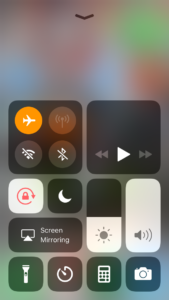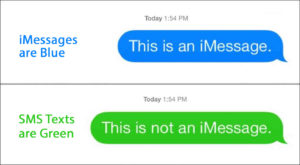To help you understand how to use your cell when traveling overseas (and what it means if you do), I’ve addressed some of my most frequently asked questions so you know exactly what to expect if you decide to keep in touch with family and friends via your mobile phone while on your next far-away adventure.
Table of Contents
How to Text Internationally for Free
Questions answered in this post
- Can I use SMS overseas over Wi-Fi?
- Will my phone use data when connected to Wi-Fi?
- How to turn off data so I don’t get charged roaming fees?
- My data is turned off, will I still get charged?
- What’s the difference between cellular data and Wi-Fi?
- Can I use my phone as a mobile hotspot?
- Should I get a local SIM card or International Sim Card?
- What services or apps can I use to send messages while overseas?
- How can I receive SMS messages overseas?
- Can I receive texts after Airplane Mode is turned off?
Can I Text Someone in Another Country for Free over WiFi?
Usually, to send an SMS or text messages, you need to be connected to a cell tower. That’s not always the case though. Times are changing and cell phone carriers are making it easier than ever to stay connected.
For example, T-Mobile has introduced texting and calling over Wi-Fi. This allows you to communicate using Wi-Fi or an internet connection as though it were a cellular connection. You still need to be careful though. Just because you’re on Wi-Fi doesn’t mean your carrier won’t charge you for data usage, international calls, and international texting.
Your best option for free international texting, video calls, and international calls over Wi-Fi while overseas is to use a third-party messaging app. Using a free app will make international texting free and allow you to communicate with your friends and family for free even when you’re in other countries – as long as you’re on Wi-Fi.
Will My Phone Use Data When I Am Connected To Wi-Fi?
It depends. Your phone cannot use both mobile data and Wi-Fi at the same time. Your phone may have settings, however, that allow you to use mobile data to connect to the Internet instead of Wi-Fi when you have a poor connection.
For example, iPhones have a feature called “Wi-Fi Assist.” When toggled, you’ll keep your internet connection (via cellular data) if your Wi-Fi slows down.
The good news is, according to Apple, your iPhone won’t make the switch when you’re data roaming.
How Do I Turn Off My Cell Phone Data So I Don’t Get Charged Roaming Fees While Overseas?
To understand roaming fees, it’s important to first understand what cellular roaming is.
International roaming is when your phone uses cellular data to access the Internet using a different cellular network than your carrier. Depending on your network carrier plan this setting may or may not be included with your international data plan. If it’s not, and you’re traveling overseas, you could incur some very large fees for international communication like SMS messaging and video calls.
Even if you aren’t actually using your phone to make calls or texting internationally, many apps use data in the background without you realizing it.
To avoid charges from roaming, you have a few settings on your phone depending on your needs:
- Airplane Mode
- Turn off cellular data
- Turn off roaming
Although turning off cellular data and data roaming will prevent your phone from using data, these won’t necessarily stop phone calls and SMS messaging. To completely avoid these costs when traveling abroad, be sure to set your phone to AIRPLANE MODE.
Airplane Mode
The simplest way to ensure you won’t be charged for roaming is to put your phone in Airplane Mode. Airplane mode will prevent you from using cellular data abroad as well as receiving unwanted international messages and phone calls. Additionally, with Airplane Mode on, you can still enable Wi-Fi which allows you to access the Internet without worrying about data plan roaming charges.
Here’s how to enable Airplane Mode based on which smartphone you have:
iPhone
Go to Settings and the very top option is Airplane Mode. Set this to ON and wait for the airplane icon to appear. Then go to the option below it for Wi-Fi. You can set this to ON so it picks up any network that is available; otherwise, just leave it off for now. 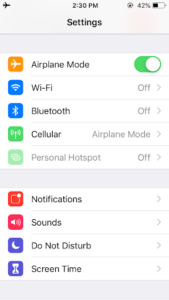
- Additionally, you can simply swipe up from the bottom of your screen and tap the top left airplane icon. If you wish to enable Wi-Fi, simply tap the button below the airplane button and wait for it to turn blue.

Android
Click Menu and go to Settings. Under Wireless & Networks, select MORE. You will see that the top option is Airplane Mode. Check the box and wait for the ON button to turn blue.
Turn Off Cellular Data
The next best way to avoid data charges is to completely shut off cellular data. This restricts all cellular data to Wi-Fi instead, keeping you from using data unintentionally for things like emails, browsing apps, and app notifications.
With cellular data shut off you can still receive text messages and phone calls, which means if your plan charges you for these, you should just turn your phone to Airplane Mode.
To turn off cellular data on an iPhone go to Settings -> Cellular and toggle the Cellular Data switch to off. Additionally, you can also swipe up from the bottom and toggle the button next to the airplane from green to grey.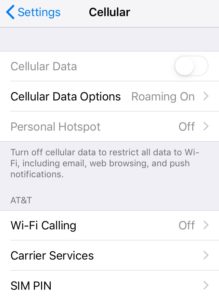
On an Android, you have more options. There are also tools that allow you to warn you when you’re approaching your monthly limit. You can also choose to use apps only over Wi-Fi.
Turn Off Roaming
Turning off roaming means that you won’t access other cellular networks when you’re out of your cell phone carrier area. Depending on your plan, you may be able to roam and enjoy unlimited texting without being charged.
Better safe than sorry though, it’s good to also put your phone in Airplane Mode when abroad.
To turn off roaming on an iPhone, go to Settings -> Cellular -> Cellular Data Options. Toggle the roaming switch from on to off.
To see how to turn off roaming on Android, you can visit here.
(Note: If you do not have a smartphone (i.e., iPhone, Android phone, or Windows phone) or a phone that allows you to turn off your data and still access Wi-Fi, then you should turn your phone completely OFF while traveling.)
If My Data Is Turned Off, Will I Still Get Charged?
As long as your phone’s data is turned off, then you cannot be charged for any data roaming charges, even with Wi-Fi enabled. You may still be able to send and receive phone calls and text message. This means depending on your cell phone plan, you might still get charged. To be completely sure you won’t be charged, you should enable Airplane Mode.
In other words, the safest way to use your phone abroad is while you are in Airplane Mode. No carrier fees will apply, and you can still enable Wi-Fi.
What Is The Difference Between Cellular Data and Wi-Fi?
The difference between carrier’s network cellular data and Wi-Fi is that cellular data is transmitted over your cell phone network (think of your cellular network like AT&T, T-Mobile, Verizon, and Sprint), whereas Wi-Fi data is over a wireless Internet network, such as what you would have when using Starbucks Wi-Fi.
Should I Get A Local SIM Card or International SIM Card?
If you’re planning on using your cell phone overseas to make cheap calls, or for text messaging, it is probably a good idea to change your SIM card. You may also need to unlock your phone. If your carrier doesn’t have an option for extended stays, then you’re going to need a new SIM card.
When getting a SIM card for international travel, you have two options:
- International SIM Card
- Local SIM Card
While they both have their own benefits and drawbacks, international SIM cards are ideal if you plan on moving around while overseas, while a local SIM card is great if you just plan on spending all of your time in one country.
Here’s some more information on both:
International SIM Card
When you’re planning to travel abroad, international SIM cards are usually the best way to go. They’re best used by someone who is traveling to multiple countries, as it’s difficult to keep track of phone numbers, unlimited data plans can get expensive, and some data carrier options can be limiting.
With an International SIM card, you get a designated phone number, and you can manage your entire account in one place. Additionally, an international SIM card is great because you can get everything set up and ready to go before you even leave – without any language barriers.
Although they can be slightly more expensive than a local SIM card, typically the small increase in cost is worth avoiding the hassle of getting a local SIM when you arrive at your destination.
One SIM Card and World SIM are some of the possible choices you have when selecting an international SIM card. 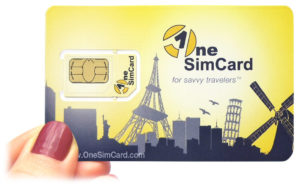
Local SIM Card
Another option if you want to get Internet while traveling abroad and not roaming, is to get a local SIM card with a data plan. Most SIM cards can be purchased at a local gas station, drug store, or, of course, one of your cell phone carrier’s stores or kiosks.
What Is the Difference Between a Local SIM Card and a Regular SIM Card?
The difference between a local SIM card and your regular SIM on your phone is that, with a local carrier, you will have a local number. This means that friends and family trying to reach you will have to text you on your local number.
For example, let’s say you go to Berlin, Germany and you get a local Vodafone SIM card. Your phone number will begin with “49,” which is the country code. It’s a great option for texting within the city, but not such a great option for contacting mom.
You do have a few options when getting a local plan, though.
- Buy a phone with a SIM card that you can recharge. These usually start at around USD $20 and you can add credit as you go.
- Buy an unlocked cell phone and purchase a SIM card. I currently have an unlocked iPhone 7 Plus with a T-Mobile SIM card on the US-based Magenta plan. This means that I don’t have to change out to a new SIM card when I arrive in a new country and I get unlimited data and texting, Wi-Fi calling, and in-flight texting. Plus, if my plan goes over, data doesn’t shut off, it just slows down. This can come in very handy when you would have otherwise been stuck with zero Internet. Also, with the T-Mobile plan in the US, you can call many other countries for only $15 per month, and international texting is free.
- Buy a phone with dual SIM, like the Sony Xperia .
Here are some examples of local SIM card providers:
- Mexico – TelCel (wider coverage) and Movistar (cheaper)
- Germany – Vodafone, E-Plus, and Telekom
- USA – T-Mobile, AT&T, and Boost
Can I Use My Phone As A Mobile Hotspot While Overseas?
Most major carriers allow you to use your compatible smartphone to act as a mobile hotspot. You just have to turn your phone on as a hotspot and connect to it via your wireless device.
However, as of this writing, I carry my mobile phone as a hotspot, as well as carry 2 additional mobile hotspots depending on whether I’m traveling in Europe or in the Americas.
If you decide to use your phone as a mobile hotspot when traveling overseas, be sure your plan includes data roaming, otherwise you’ll be racking up a huge bill.
What is Mi-Fi?
Mi-Fi is a brand name for a wireless device that functions as a mobile Wi-Fi router. Your device may or may not technically be a Mi-Fi device, but the term has become shorthand for any mobile hotspot.
A mobile hotspot will typically work in a wide range of countries. Many of these devices use “virtual” SIM cards that allow you to change regions with just a few buttons.
Does my Mi-Fi work in other countries?
It isn’t enough to simply have a mobile hotspot, you need to be certain that your device is actually going to work in the places you travel. Many countries actually have different service frequencies, which means a lot of devices (even “unlocked” ones) may not work all over the globe.
When you purchase a Mi-Fi device, be sure to check how many frequencies it supports. The more it supports, the better it will do on your globetrotting adventures. For an in-depth guide, check out Best Mobile Hotspot Devices [2022].
Subscription vs. non-subscription Mi-Fi devices
Traditional Mi-Fi devices are non-subscription. You insert your SIM card and the device creates a mobile Wi-Fi network with a password that you can connect your devices to. However, in the last few years, a new breed of Mi-Fi device has become prominent: the subscription model.
Think of subscription Mi-Fi like a hotspot crossed with a global data plan. With these devices, you have the option to swap out the SIM card associated with your global plan and replace it with a local SIM, giving you 100 percent control over when you use your plan data and when you don’t.
How to Text Overseas: What Services or Apps Can I Use?
Most travelers and remote workers want to know how to receive text messages overseas without roaming. They want to know ways to send free text messages and voice messages, get free data, or other free services while traveling abroad.
Typically, you aren’t technically sending SMS messages or “international texting” when you have Wi-Fi on and data off, but you can still enjoy SMS messaging or send text-like messages to your family and friends using services like these.
Even now with Wi-Fi-enabled ways to send text messages and calls, your provider still may charge you the same as for a normal text message.
(Note: If you have AT&T, Verizon, Sprint, or a regular T-Mobile cellular plan and you set your phone to Airplane Mode, you will not be able to send text (SMS) messages.)
To text with a family member, a friend, or go on group chats while abroad, make sure your Wi-Fi is turned ON and that you both have one of the following services on your phones:
How to Send Texts Over WiFi
iMessage
This option causes the most confusion and the reason is that if you and five of your friends all have iPhones, each iPhone user can engage in “text messaging” as if nothing ever changed. However, you aren’t actually sending international texts; you’re just using Apple’s messaging service to send correspondence (or send “text messages”) back and forth over a Wi-Fi connection. Therefore, you can only converse with others who are also iPhone users or use an Apple device.
Does iMessage Work Internationally?
With iMessage, you can still send text messages and receive messages abroad while data is turned off. You can iMessage free internationally. And if you’re in Airplane Mode but have Wi-Fi set to “on,” then you can receive iMessages which appear like text messages but they will be in blue versus green, like this:
Ultimately, you will not receive the green message when you are abroad and your cell phone data is turned off. So, if you have data turned on and you see green messages – look out! You may be getting charged insane rates. Remember, Airplane Mode – on; Wi-Fi– on.
Google Voice
This one has been around for a while and is still quite functional, but not the most popular messaging app. To use it, simply download the Google Voice app, sign up for a Google Voice phone number (free in the U.S.), and you can send international texts back and forth from that number. They will appear on your phone via the app, allowing you to send messages overseas as much as you’d like!
Google Hangouts may start to soon replace Google Voice, but for now, it’s still a great option and I use it all the time for international messages and even voice messages. At the very least, it’s like having a second number on the same phone so you have two options. Give friends and clients your Google Voice number so you’ll always have a local US number for international texts.
WhatsApp became very popular when it was acquired by Facebook for $19 billion. To utilize it, just download Whats App, find your friends, and send messages back and forth. It’s not the first of its kind, but it is fairly popular and growing in popularity. If your friends are tech or travel savvy, or if they/you are European, you’ll most likely find them here. It’s a must-have app for travelers or for communicating and texting your friends overseas.
To use WhatsApp (and all the other apps), you must be connected to Wi-Fi.
A kind of fun feature of WhatsApp is that you can send MMS, or picture messages, for free as well – all over Wi-Fi.The images will also automatically be added to your photo album on your phone (at least on iPhone). No more asking your friend to share an album with you and no more having to ‘save image’; it just shows up.
Viber
Not dissimilar to Google Voice and WhatsApp, Viber takes the best of the two and combines them. Once you download the app, you find your friends who are also using Viber, and you can connect immediately. The nice thing about this particular messaging app is that, not only can you send free messages back and forth inside of the app, but you can also make free calls. Viber even uses your cell phone number as your identifier.
There are a growing number of options for sending messages to family and friends, and these are just a few. For instance, GroupMe is another popular group messaging app that allows you to communicate with a number of people at once (and you can still use emoji!).
For more international texting options while traveling overseas, I suggest you read: Top 7 Communication Apps to Use While Travelling.
How Can I receive SMS Messages Overseas?
When traveling overseas, you have a few different options for receiving SMS messages:
Option 1 – International plans via US carriers
For most providers, you have an option to use an international plan, which covers international texting. Here are some common providers, and some of the options available for international plans:
T-Mobile
The T-Mobile Magenta plan is great for short trips, where you don’t plan on staying abroad for an extended period plan. With the T-Mobile Magenta plan, international texting and data are unlimited in 210 countries and nations. This plan also includes calling landlines in 70+ countries, or calling and texting to cell phones in 30+ countries. You can check to see what kind of coverage you will have here.
Verizon
Verizon offers multiple plans for either short or long term international trips international plans depending on how connected you need to be.
If you’re having a difficult time deciding which plan you need, Verizon also has a great guide to help you pick out what plan or upgrade you will need for your travels.
Sprint
With Sprint, you have free unlimited SMS and basic data abroad with any smartphone enabled plan in 200+ countries. You only have to pay $.25/call while abroad.
AT&T
AT&T offers a passport plan for either short term trip or for extended international stays.
Option 2 – Google Voice Phone Number
If you’re looking to ditch your cell phone contract, Google voice is a great option. This allows you to be able to send and receive text messages and phone calls via Wi-Fi, making this a much cheaper option. All you have to do is set it up and tell your friends and family about your new phone number.
Additionally, if you’re not on Wi-Fi, Google voice will transcribe the audio so you can read it later. You can use the google voice app to text or you can text via Wi-Fi anytime you’re on Wi-Fi.
Can You Text on Airplane Mode?
This varies depending on each provider, but as a general rule, anytime you need to have your cellular data shut off for more than 2 days (48) hours, you may not receive the messages sent to you.
Each provider will have a unique “retry” period, in which it will attempt to send the message. If the message is not delivered within this period, the provider will stop trying to send the message, and it will be discarded.
Summary Of International Texting
Just to hammer the main points home –
DO NOT send SMS messages or text messages while traveling overseas unless you want to pay out the nose for them. (Also remember that it’s usually not possible to send SMS over Wi-Fi.)
You CAN receive SMS messages/texts, but you might pay for them. So turn off your cell phone data by putting your phone in Airplane Mode and turning on Wi-Fi.
You CAN receive messages (non-SMS) over Wi-Fi, for free.
You CANNOT send or receive SMS messages (“texts”) via your cell phone carrier when you are in Airplane Mode.
Eventually, we may not even need cell phone carriers to keep in touch but, until then and until you get rid of your cell phone plan, be careful of extra charges when traveling overseas. They’re simply not worth it when you have so many free options available.
Again, just remember that SMS is always associated with your carrier (AT&T, T-Mobile, Sprint, etc.) and a message can be either a text message synonymous with SMS or a non-SMS text message image, or other form of communication.
What Have YOU Learned about Sending SMS or Text Messages Overseas? What Would You Like to Learn?
Do you have other questions or see anything I’m missing? Please feel free to drop your questions or comments below.

